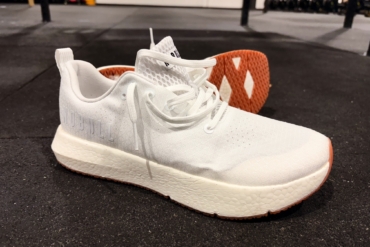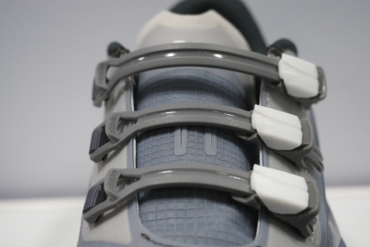Last year, Vimazi came out with a bold claim: it could make a running shoe designed for a specific running pace. In doing so, this “pace-tuned” shoe “helps maximize runners’ performance at different pace ranges.” Compared to whatever random sneakers you typically wear to the gym, or even a quality pair of road running shoes with the correct amount of shape, support, or cushioning you need — Vimazi’s claim is that these are better.
Now, they won’t necessarily make running at a certain pace easier, or more comfortable (and no, they won’t help you run faster) — they are simply designed to help sustain a runner at a certain pace. Also, to provide the correct amount of responsiveness you need whether you run at a pro level, super-fast, fast, middle-ground, or leisurely pace.
If you are looking into the Vimazi, we recommend investing in a pair tuned to the pace you usually run at most often. Though, for the sake of our testing, I wanted to see how the Vimazi could hold up to faster paces for training purposes. For me, this meant picking a pair which I would use for faster-paced workout runs, instead of casual/lazy/social runs or jogs with my dog.
So, I tested the middle-ground Vimazi Z40, one of six in the Z series. With the Vimazi Z40 shoes, I didn’t run super-long mileage — instead I opted for shorter, high-intensity training runs and treadmill runs (for monitoring my pace) as often as I could. Over my months of testing, I’d say my initial testing runs averaged 3-5 miles.
In short: I’ve now been running in the 2022-released Vimazi Z40 shoes since spring. It’s the tail end of summer, and like most people, I’m juggling tons of activities — hiking, biking, travel, paddling, climbing, and whatever else crops up on a beautiful day outside. When I’m able to squeeze in a few runs each week, it’s nice motivation knowing that when I slip into my Vimazi shoes, I mean business.
They are meant for running at a certain pace, and obviously, they will offer the best performance if you adhere to the pace they are built for. They do have some great technical aspects, and then some qualities that are hit or miss, depending on you as a runner. But overall, the Vimazis aren’t just tuned to provide the best support and shock reduction from push-off to end of run, but also to put some fire underneath you as well.

For everyone who already has a good solid running or training regimen, and who runs at faster speeds — you’ll probably really enjoy the Vimazis. They are built well with a comfortable supportive midsole of varying densities (this is the “pace-tuned” part) and next-level heel cushioning. The upper is breathable and hugs your foot nicely, and the lacing system stays put. And, the price isn’t bad.
- Materials: Rocker design, EVA base, proprietary EVA blend midsole, fortified arch
- Stack: 29mm
- Drop: 5mm
- Available sizes: 6-11 (women's), 8-14 (men's)
- Claimed weight: 230 g, 8.1 oz. (size 9)
- Verified weight: 8.1 oz. (size 8)
Pros
- Comfortable at pace/speed
- Supportive and responsive
- Great arch support
- Unique design
Cons
- Higher heel cradle isn't comfortable with shorter ankle socks
- Softer heel not great for heel-strikers
- More expensive
Vimazi Pace-Tuned Z40 Running Shoe Review

I’m picky about running shoes. I like ones that are soft and light but not squishy, versus stiff and bulkier (looking at you, max cushion shoes). I have a narrowish foot and a high arch. For road shoes anyway, I already have my favorites. But Vimazi has made some bold claims, and I wanted to see if these shoes really worked.
Off the bat, the shoes are comfortable, with quality materials, and what seemed like a sturdy construction out of the box. Especially since they are tailored for the faster ~7:00/mile pace, Vimazi made sure to address specific points of high use and wear, and then build that into the shoe. Here’s a quick explainer you’ll see on the spec sheet for the Z40s:
“At 7 minutes per mile, your flight distance is quite long, which means you generate a lot of force on impact. To account for that specific impact force, we tune the reaction density of the heel and midfoot to optimize cushioning you get. We call this pace-tuned cushioning.”
For the Z40, Vimazi continues with a quick explainer on why it chose x amount of midsole, and x amount of drop for this shoe:
“At this pace it takes a lot of force to propel yourself forward, so the last thing you want is a squishy, inefficient midsole. We’ve tuned the forefoot in the Z40 to deliver maximally-efficient energy return given the forces at this pace. Runners at this pace are usually light in weight and often midfoot strikers.”
Yup, that’s me through and through. It’s good to know I picked a shoe that not only caters to my target pace, but also to the type of runner I am. “With this in mind, we built a 5mm drop into the Z40,” the final sentence on the drop section reads.
But enough background. On to my verdict.
Overall Design: Z40 Targets Performance and Comfort

On spec, this is a fairly straightforward road running shoe. It consists mostly of EVA foams, it’s not bulky, it’s got a low heel-toe drop, and it feels fast. It’s not overbuilt. It fits my narrow foot well, but I would say runs true to size overall. I’m honestly not sure how well it would fit wider feet.
Vimazi makes a lot of techinical adjustments across each shoe model for different paces, in the forefoot, midfoot, and heel areas. (The first time I saw the brand, I tried on a few models, but have only tested the Vimazi Z40.)
Another thing: the Z40s are insanely comfortable. They may feel like just any other running shoes when you put them on … but they are so different once you run in them. I notice my form more, and each strike on the pavement feels more comfortable than other shoes I’ve tried.
That being said, there’s enough cushion and stack that there’s almost no ground feel — you won’t feel much of the pavement beneath you. There’s lots of heel cushioning, but no heel slip. Plus, arch support. Two big wins in my book.
The Pace-Tuned Shoes in Testing
Editor’s note: For all of my review statements on fit, feel, and performance, note than I am referring to the feel of the shoe at the target pace (~7-minute mile window), unless I note otherwise.

Now, do I run at a 6:15/mile pace? Heck, no. Not even on a good day. So consider this disclaimer: I am not a competitive runner, and definitely not a sprinter. In high school track, I always ran the 1-mile and 2-mile, never the 400m. However, do I run to work out? And do I like pushing myself with faster workouts? Yes and yes.
While I almost never run a 6:15, I often run at a 7:15-ish pace. Since these shoes cover the 7:00-7:45/mile window, I figured they’d be perfect for all my serious workouts, targeted training, and early morning runs. Do I also sometimes run in the 8-8:30/mile pace, or even the 9:00/mile if I’m jogging with my dog? Sure. And that’s where Vimazi’s other models, the Z50 and Z60, may come in.
To me, Vimazi’s “pace-tuned” marketing seems to most benefit the serious and committed, above-average but not ultracompetitive, runners. For casual runners who don’t wear or test a lot of different shoes and who might run at a slower pace, who knows if these would make a difference.
But for those who run fast/faster, and often, who want to perfect or better their form, and who do care about investing in performance shoes — that’s who Vimazi is for, in my opinion.
Treadmill Testing and Training

In my first test wearing these shoes, I wore them on a 2-mile treadmill run at a ~7:30 pace, then a 1-mile run bumped down to a 7-minute mile. I picked a treadmill for exactly this reason: I could track my pace in real time, without having to cross roads, sidewalks, or look down at my watch like when running outside.
I also wore them around my home gym for some planks, lunges, high knees, and splits to stretch out. The shoes run true to size, maybe a hair narrow toward the toes.
The next few times I tested the shoe, I wore them either (again) on treadmill runs, or in a closed path loop (pavement/road) at my neighborhood park. This was more realistic/real-world training for me, and where I’d probably use the shoes most often for workouts. Overall, I’ve probably got about 50 miles on the shoes so far. And, they’ve worked great — for all the reasons I’ve listed above.
It may sound gimmicky, but at pace, they really do feel different. They perform well, and they are supportive. Are they magic? No. But are they pretty great shoes? Yeah.
Conclusion

I’ll be honest, after a whole lot of running (in the overall pace window and at my targeted test pace of 7:00), I don’t really have any gripes about these shoes — other than that they are white! I know road running is different than trail, but no matter what type of running I do, I seem to scuff up my shoes so fast. The other models all trend toward darker colors, so maybe just consider those for if you are like me and want a pace-tuned option but really eschew white shoes.
Finally, the price. The Vimazis are $175, which is not bad for a race or training shoe. But, it’s also more expensive that some other options from the likes of HOKA and Asics (something in the $140-160 range would be ideal for my personal budget). Though, this is a new and smaller company to market, and it’s doing pretty cool things with these shoes.
In conclusion, the Vimazi Z40 and its Z Series comrades are worth checking out if you really want to boost your running performance. Remember — whatever your pace is, Vimazi has a shoe for it.











